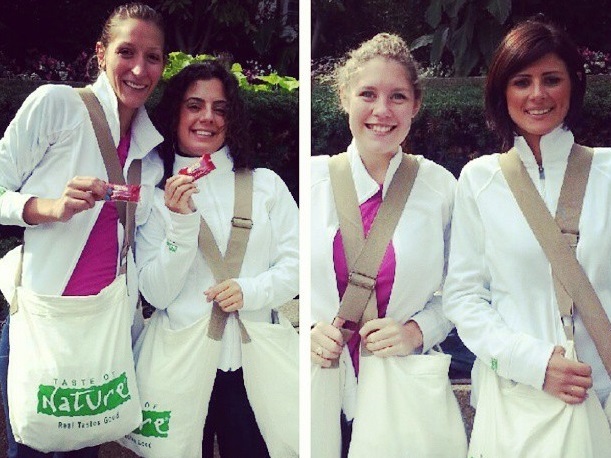Event Planning on a Budget! Tips & Hints to Help you Get Started

4 Tips to Ace an Interview and Land an Amazing Job for Back to School!
September 6, 2014
Tigris Events Staff Promote Healthy Eating With Taste of Nature Street Sampling!
September 17, 2014Stretch your Dollar When You’re Event Planning on a Budget
Anyone working in the not-for-profit sector can tell you that event planning on a small budget can be a challenging and sometimes overwhelming task. Charities often rely heavily on hosting events in order to bring the public together to support their cause and to raise funds that go towards the greater goal. But how do you create an event to yield money when you barely have enough funds to put into it?
Pinpointing your goal in hosting this event will help you narrow down the type of event you may want to have, and will help you to set the scale whether large or small. Events could range from a neighbourhood BBQ, team sporting events, or a lunch-and-learn session, to large scale galas, or an outdoor festival. The type of event you host will be largely determined by the overall goal.
When money is an issue, it is time to count on organization, creativity, and help from outside resources.
But, first thing’s first. It’s time to organize priorities. So where do you start?
The First Question in Event Planning -> What Are you Hoping to Achieve?
-> Are you looking for create awareness?
-> Do you need event planning support from other committee members?
-> Are you looking for financial donors?
-> Do you want this to become an annual event?
-> Are you hoping to open the forum for networking?
For a larger event to be planned and executed effectively it is a good idea to recruit a team of people, a committee of individuals, who can individually take on a critical element of the event that is their own to plan and organize. Leaning on a temporary staffing agency could be a resource – but of course, this depends on your budget.
When I used to work with the Canadian Cancer Society, when planning a large and lengthy outdoor event, I relied heavily on the particular skills of my committee members to help execute different components for the event. As the the Committee Head, I ensured the action items at each meeting were in fact carried out, and that time lines helped defined the next steps. I then chose to delegate portions of the event responsibilities to people who were skilled in or had connections in particular areas. We termed these folks the ‘chair’ of their portion of the event.
Examples of committee member responsibilities could include:
Sponsorship/Fundraising Chair – this individual would use networking connections to formally request donations to the event in the form of gifts that could be auctioned off or sponsorship dollars from companies that could be exchanged for marketing at the event
Volunteer Coordination – responsible for securing help for event days tasks, this team member would recruit, assign and manage volunteers. They would recruit candidates, assigns activities and from an event planning perspective, provide training for the event in advance. They would also likely coordinate the team onsite the day of the event.
Decorating Chair – this person would be in charge of making the venue look spectacular. They would see that the overall look of the event is well planned and attention to detail is paid to the lighting, place settings, gift bags, etc
Marketing Chair – ensuring the event is marketed effectively to the target demographic is a huge responsibility. Without attendees, you have no event! The person designated to this role could use volunteers to post/hand out event flyers, secure radio time to promote the event/encourage attendance, canvas local businesses etc. To support the growth of the event, they could also invite a newspaper or television station to report on the event and take footage or photos.
This is just a small selection of the ways that you can utilize the help of others, their skills and creativity to execute an amazing event that is low on costs. Many hands make light work! Delegation is key in the not-for-profit industry. Along with splitting tasks with a team, it helps to be creative! If you’re able to use free resources to your advantage, there are countless ways to stick to a budget and keep the quality high, the key is knowing what is – and who are – available to you.
In terms of taking a do-it-yourself approach to decorating, one website that I found to be particularly helpful in the way of giving great ideas for personal and professional event planning is Pinterest. Pinterest is a company that provides an Internet service that they describe as a ‘visual discovery tool’. People use Pinterest to collect ideas for projects and interests. Users create and share collections (called “boards”) of visual bookmarks (called “Pins”) that they use to do things like plan trips, develop projects, organize events or save articles and recipes. It is a wonderful way to see what is trending and has very cost effective way of showing you some easy ways of making an event look great without spending big money.
In addition to the Canadian Cancer Society, I also spent some time working at a retirement home. I made it my mission to use creative and fun ways of hosting parties for the residents and their families. From week to week, I chose a theme for the events, and would use the assistance of the seniors in either a food prep or craft class program to create decorations or prepare a baked snack for the event. I utilized my resources -> in this case, the seniors, to socialize and learn while stringing together flower leis for our upcoming Hawaiian Luau, or to make no-bake pudding pies for a Friday Afternoon High Tea. Sometimes a little creativity can go a long way and everyone was happy working together as a team.
As a charity, all eyes will be on where your spending goes. People, especially event attendees, want to know that their dollars are going to the cause, and not into lavish spending. Accountability is everything so ensuring you are maximizing dollars for your cause is of utmost important.
We hope these tips have been helpful. If you’re thinking about planning an event, give us a call at 647-286-9392 . Our event planning services are available at top locations including Toronto, Calgary & Vancouver and we’d love to help!




